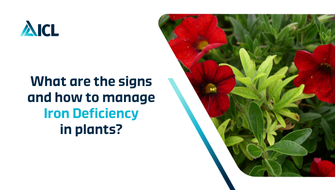After Nitrogen, Phosphorus and Potassium (NPK), Magnesium (Mg) is the fourth most important macronutrient required by plants. Some, such as roses and rhododendrons, are particularly hungry for Magnesium.
An essential nutrient for plant health, Mg plays a key role in chlorophyll synthesis and various physiological processes. A deficiency can hinder photosynthesis, which is essential for plant energy production and growth, and impair absorption of other nutrients – leading to secondary nutrient deficiencies.
What are the symptoms of Magnesium Deficiency?
- Interveinal chlorosis – prominent symptom with tissues between veins of older leaves turning yellow – while veins remain green. Mg is a central component of the chlorophyll. (It is worth noting, that if this symptom is seen in new leaves, it is mostly like Iron deficiency).
- Leaf curling – in severe cases, leaves may also show curling or cupping.
- Stunted growth – reduced plant growth, in terms of height and overall size.
- Leaf drop – older leaves may drop prematurely.

Magnesium Deficiency in Cham. Laws. Ellwoodii
Water quality and Magnesium deficiency
Water quality is important as soft water tends to be highly pure, and therefore low in Mg as well as Calcium. Nurseries relying on soft mains water, or rainwater harvesting, can take action to avoid Mg deficiency in their crops. ICL’s great value, versatile Universol® Soft Water range, and premium quality Peters® Excel Soft Water range, are designed to improve the quality of soft irrigation water.

Magnesium Deficiency in Ficus
How should you manage Magnesium Deficiency?
ICL offers two specialist ranges to help prevent magnesium (and calcium) deficiency.
Versatile, value Universol soft water range
- Universol Soft Water 312R (18-7-12+6CaO+2MgO+TE) Ideal to encourage early crop growth stages and optimum leaf colour.
- Universol Soft Water 213R (14-7-22+5CaO+2MgO+TE) Ideal for flowering and crops and compact growth.
- Universol Soft Water 113R (11-11-31+2CaO+2MgO+TE) Ideal for flowering crops and to harden off crops in final growth phase.
Premium quality Peter Excel CalMag range
- Peters® Excel CalMag Grower (15-5-15+7CaO+3MgO +TE)
Premium quality water soluble fertiliser for soft water with a balanced N:K ratio to promote healthy growth, CalMag Grower contains extra Mg.
- Peters® Excel CalMag Finisher (14-5-21+7CaO+2MgO +TE)
Often used as a follow-up to CalMag Grower, this single-tank mix premium quality fertiliser provides all the essential nutrients, including Mg. With a high K formula, it produces compact condensed growth and is compatible with calcium nitrate.
Micromax® Premium
This high-performance granular fertilizer contains 15% MgO (slow-release magnesium), plus all essential trace elements in a single application. Designed for maximum efficiency, it:
- Supports healthy plant growth for up to 16 months.
- Works effectively even in growing media with a pH above 6.5.
- Is easy and safe to use.
Micromax Premium is a key ingredient in our Levington Advance bagged range and Levington Advance bespoke mixes – with higher rates recommended for peat-reduced/free mixes.
Did you know?
- Sustainable growing media mixes (peat-reduced/free) contains less dolomitic lime, so the potential risk of magnesium deficiency increases.
- Growing media mixes with coir can contain high levels of potassium, which impacts negatively on magnesium uptake.
- Over irrigating can contributing to nutrient leaching. Properly timed and measured irrigation can help nutrients, including Mg, stay available to plants.
- Cold borehole water can impact on magnesium uptake by plant roots.

Magnesium Deficiency in Guzmania
0 Brands found
0 Products found
13 Resources found














